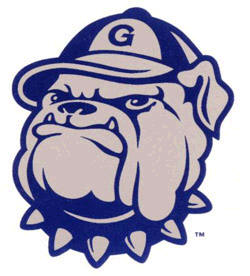This is a must-read. It points out the differences between the last dominant Hoyas teams and the new version. As discussed, the newer model is clean-cut and not all that physical. Let's just hope we can have some apparel sales anywhere close to what GU had in the 1980s.
The World's Most Dangerous Basketball Team
How the Georgetown Hoyas changed college basketball
No program since John Wooden retired has left as deep an impression on basketball's collective psyche. Not Phi Slama Jamma. Not the Fab Five. Not Rick Pitino's Kentucky teams. Certainly no team involving Christian Laettner. And the students have it right: Fear is what made Georgetown memorable.
Part of it came from the Hoyas' style of play. They pressed up and down the court, trying to force turnovers and low-percentage shots. Patrick Ewing, and later Dikembe Mutombo, stood in the lane swatting (and often goaltending) shots away, shooting intimidating glances across the floor. Meanwhile, John Thompson the elder, a giant man with a white towel tossed over his shoulder, patrolled the sideline with a scowl. The Hoyas won a lot, too, reaching three national finals between 1982 and 1985.
But the fear, back then, had as much to do with race as hoops. Georgetown basketball under John Thompson was always intertwined with racial politics. That was inevitable when an elite Eastern university, then as now overwhelmingly white, started fielding teams made up almost exclusively of black players. When Thompson came to Georgetown in 1972, he wasn't plucked from some other sideline legend's "coaching tree." Rather, he had been plying his trade at a tiny Catholic high school in northeast Washington, D.C., at a time when the only notable black coaches were Lenny Wilkens and Bill Russell—both player/coaches for NBA teams.
. . . .
Around the time Georgetown won the 1984 national championship, the university trademarked the Hoyas name and snarling-bulldog logo. This was the first college sports team to become a brand—and it was a tremendously lucrative one. By the early '90s, Georgetown apparel outsold even schools with powerhouse football programs. Georgetown Starter jackets sold well across the country, but the team's image was especially resonant in black America. Not only was this an all-black team with a black coach, the Hoyas also played in a majority-black city run by a black mayor. Thompson took a well-publicized stand against Proposition 42, an NCAA rule change that he believed would threaten black athletes by imposing higher academic standards. Eventually the racial cues became more overt, most famously in the kente-cloth-trimmed uniforms of the Iverson era.
Eventually, touchstones of black culture spread from Washington, D.C., to every corner of college hoops. As revolutionary as Thompson's teams might have been, he always remained a traditionalist. Michigan's Fab Five made baggy shorts iconic, and Iverson didn't grow his famous cornrows until he left the Hoyas. It wasn't just the culture that passed Thompson by. His defenses became less effective with the rise of the 3-point shot and swingmen who could handle the ball and take it to the hoop. When Iverson left, the dying embers of Georgetown's place in popular culture went with him—the school's licensing revenues have dropped out of the collegiate Top 50 in recent years, overtaken by the likes of Boise State.
http://www.slate.com/id/2162970/
Thursday, March 29, 2007
Subscribe to:
Post Comments (Atom)


No comments:
Post a Comment